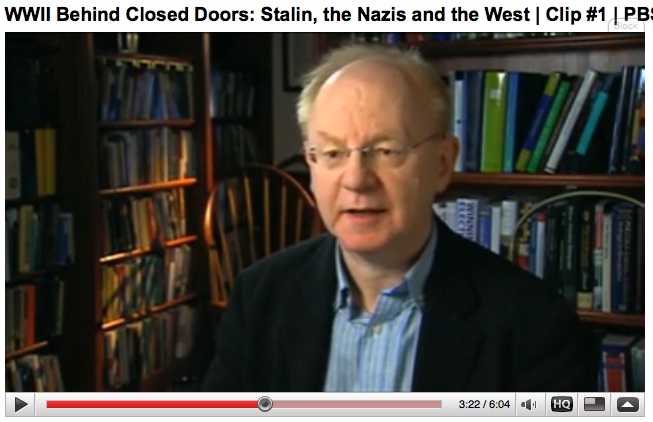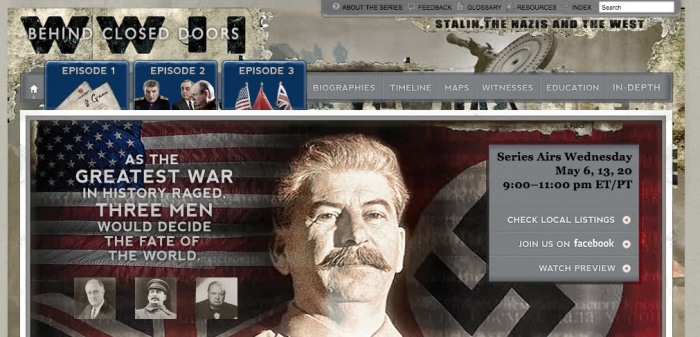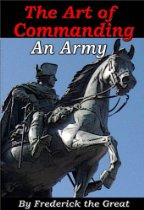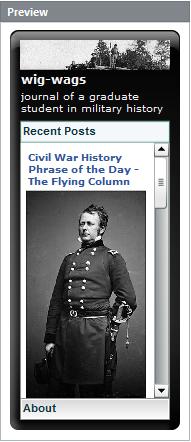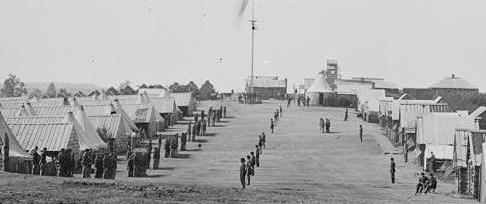Posts Tagged ‘Military History’
Class starts today! Civil War Command and Leadership
Class starts today!
Civil War Command and Leadership
The book list changed a bit since my first post. That’s ok. The books I picked up for the old book list are good ones.
Professor: Steven E. Woodworth
I’ve updated the courses page with the information below.
Required Texts:
Glatthaar, Joseph T. Partners in Command: The Relationships Between Leaders in the Civil War. New York: The Free Press, 1993.
McPherson, James M. Tried by War: Abraham Lincoln as Command-in-Chief. New York: Penguin, 2009
[Course professor] Woodworth, Steven E. Jefferson Davis and His Generals: The Failure of Confederate Command in the West. Lawrence, KS: University Press of Kansas, 1990.
Military History Word of the Day: “Refuse”
Refuse
Military. to bend or curve back (the flank units of a military force) so that they face generally to the flank rather than the front.
refuse. Dictionary.com. Dictionary.com Unabridged (v 1.1). Random House, Inc.http://dictionary.reference.com/browse/refuse (accessed: August 08, 2009).

It is not surprising that McClellan did not immediately decide to employ his left wing under Franklin to relieve Harpers Ferry. In focusing on Frederick for the past several days, the Federal right had not only advanced quicker and farther, but the left had angled northward toward Frederick. In consequence Burnside was now considerably nearer Harpers Ferry than Franklin. Moreover, McClellan needed to refuse his left flank along the Potomac until he learned the meaning of the rumor that Jackson had recrossed the river at Williamsport. Lincoln may have jumped to the conclusion that the Confederates were retreating, but the possibility of a turning movement could not be dismissed lightly.
1. Joseph L. Harsh, Taken at the Flood : Robert E. Lee and Confederate Strategy in the Maryland Campaign of 1862 / [book on-line] (Kent, OH: Kent State University Press, 1999, accessed 8 August 2009), 209-210; available from Questia, http://www.questia.com/PM.qst?a=o&d=102364919; Internet.
Military History Word of the Day: “Ambuscade”
–
am⋅bus⋅cade
[am-buh-skeyd] noun, verb, -cad⋅ed,
–noun
1. an ambush
–verb (used without object)
2. to lie in ambush.
–verb (used with object)
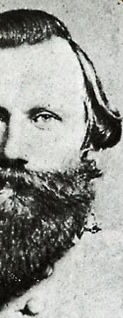
Jeb Stuart
3. to attack from a concealed position; ambush.
1575–85; < MF embuscade, alter. (under influence of OF embuschier) of MF emboscade < OIt imboscata, fem. ptp. of imboscare, v. deriv. with in- of bosco wood, forest < Gmc *bosk- bush
Related forms: am⋅bus⋅cad⋅er, noun [1]
—-
As used by Joseph L. Harsh in Taken at the Flood…
On this occasion, Jeb Stuart justified his reputation for alert reconnaissance. Almost instantaneously he perceived and reported to Lee the enemy’s rapid withdrawal. He also ordered Hampton to pursue and harass the Federal column retiring from Flint Hill toward the Chain Bridge. Into the hours of darkness, Hampton closely pressed the Federal tail under Sedgwick, lobbing shells into the panicky main body until the heavy casualties suffered by the 1st North Carolina Cavalry in an “ambuscade” laid by the 71st Pennsylvania Infantry bought breathing space for the retreating Federals. Meanwhile, in the center of the line, where Stuart had only Fitz Lee’s tired troopers, the Confederate horsemen pressed more gently and permitted Hooker to withdraw through the county seat virtually unscathed. Heros von Borcke, Stuart’s Prussian chief of staff (see his memoir online here), planted the Confederate colors on the courthouse green, while deliriously happy Southern sympathizers mobbed the troopers, and damsels showered Stuart with kisses. Jeb even found time to visit his friend and “spy” Antonia Ford. [2]
—–
[1] ambuscade. Dictionary.com. The American Heritage® Dictionary of the English Language, Fourth Edition. Houghton Mifflin Company, 2004. http://dictionary.reference.com/browse/ambuscade (accessed: July 25, 2009).
[2] Joseph L. Harsh, Taken at the Flood : Robert E. Lee and Confederate Strategy in the Maryland Campaign of 1862 / [book on-line] (Kent, OH: Kent State University Press, 1999, accessed 25 July 2009), 19; available from Questia, http://www.questia.com/PM.qst?a=o&d=102364729; Internet.
WWII Behind Closed Doors: Stalin, the Nazis and the West Premiering May 6 on PBS
In an earlier post, I mentioned that I’d been contacted by a publicist at PBS to preview the upcoming documentary that begins airing this week (May 6th), WWII Behind Closed Doors. I’ve had a chance to watch the full documentary and found it fascinating.
When I think of PBS, I think of credibility. Add credibility to reenactments performed by an extremely talented cast, the drama of war on a global scale, and the intrigue of information hidden from the public for decades, and the result makes for excellent viewing.
The story largely centers around Joseph Stalin – his hatred of Poland, betrayal by Hitler, paranoia and its impact on his leadership cadre, dealings with Churchill and Roosevelt, and hand in decisions that doomed millions. It also depicts how a few leaders determine the fate of nations. The deception around Stalin’s atrocities against Poland, these lies perpetuated by England and the United States, is startling. Another of the documentary’s highlights is its presentation of the war from the view of the Poles.
This from the publicist…
Rare wartime documents made briefly available only after the fall of the Soviet Union help reveal the real story of confidential meetings held during the war between c. Award-winning historian and filmmaker Laurence Rees (Auschwitz: Inside the Nazi State, Nazis – A Warning from History) tells the hidden story of Stalin’s back room dealings – first with the Nazis and then with Roosevelt and Churchill. By juxtaposing conventional documentary elements with dramatic recreations, WWII Behind Closed Doors breaks through the myths of the Allied powers, illuminating the hidden motivations of “The Big Three” and creating a dynamic reappraisal of one of the seminal events in world history.
View an excellent video on the making of the series here.
For full information on each episode and a wealth of additional information, see the PBS program site here or by clicking on the image below.
For more information on Laurence Rees, see his website here or by clicking on the image below.
Upcoming PBS Special – WWII Behind Closed Doors
A PBS publicist contacted me today about an upcoming special special, WWII Behind Closed Doors: Stalin, the Nazis and the West. The six-hour series airs Wednesdays, May 6, 13 and 20, 9:00 – 11:00 p.m., on PBS.
DVDs are on their way so more to come after I view them. Sounds very interesting.
Beginning a search for a thesis topic…The American Civil War
I am going to begin in earnest to find a suitable topic for my thesis. I don’t expect to have one locked in until I get another course or two under my belt but I am interested in the opinions of many of you who I would consider expert on topics of Civil War military history. Where are there gaps in scholarship that need filling from your perspective?
Let me hear from you!
American Rifle, A Biography
Under the guise of a Christmas gift for my husband, I have acquired a copy of Alexander Rose’s new book, American Rifle, A Biography. I have reluctantly agreed with him that he should thus have the opportunity to read it first.
Alex has been getting some outstanding reviews including one from the Washington Post which you can read here. You can catch up on more reviews over at Alex’s blog here.
Hardcover: 512 pages
Publisher: Delacorte Press (October 21, 2008)
Language: English
ISBN-10: 0553805177
ISBN-13: 978-0553805178
Product Dimensions: 9.1 x 6.1 x 1.5 inches
Crusade: The Untold Story of the Persian Gulf War
Rick Atkinson. Crusade: The Untold Story of the Persian Gulf War. Houghton Mifflin Company, 1994. See the publisher’s book site here.

Pulitzer Prize winning author Rick Atkinson presents as narrative history the Persian Gulf War from its opening salvo to the American victory parade in the nation’s capital. His stated purpose is to tell the story of this “limited war,” certainly, but in doing so, he reveals much about America’s military elite and their need to heal from the failures of Vietnam. He exposes a heightened intra-service competition not unexpected in a campaign of this size but indicative of the growing role of air power in limited war. He also presents a study in leade rship and a particularly frank examination of the Schwarzkopf war room which most senior commanders feared entering due their leader’s explosive temperament and demoralizing criticism. It is Atkinson’s view that his leadership style actually prevented, to a significant degree, decentralization of initiative conducive to effective field command. The book demonstrates well that the America of the 1990’s had reached the level of superpower. Equally revealing is the jockeying for power among Schwarzkopf’s commanders. Atkinson makes a clear case for the lopsidedness of the war evidenced by an American technological and logistical strength unparalleled in history. He also emphasizes the advantages enjoyed by America’s dominance of the air and the crucial role that played in the conflict’s outcome. But he concludes that the American and allied war machine was not flawless. Weapons technology proved in some cases finicky, airplanes vulnerable to Iraqi anti-aircraft batteries, and friendly fire mishaps unavoidable.
rship and a particularly frank examination of the Schwarzkopf war room which most senior commanders feared entering due their leader’s explosive temperament and demoralizing criticism. It is Atkinson’s view that his leadership style actually prevented, to a significant degree, decentralization of initiative conducive to effective field command. The book demonstrates well that the America of the 1990’s had reached the level of superpower. Equally revealing is the jockeying for power among Schwarzkopf’s commanders. Atkinson makes a clear case for the lopsidedness of the war evidenced by an American technological and logistical strength unparalleled in history. He also emphasizes the advantages enjoyed by America’s dominance of the air and the crucial role that played in the conflict’s outcome. But he concludes that the American and allied war machine was not flawless. Weapons technology proved in some cases finicky, airplanes vulnerable to Iraqi anti-aircraft batteries, and friendly fire mishaps unavoidable.
Mr. Atkinson comes to the task of authorship with impressive credentials. A graduate of East Carolina University and the University of Chicago, his most impressive qualifications come from a strong record of investigative and writing skills. His role as primary correspondent for the Washington Post during the Gulf conflict certainly put him in the thick of that which could be revealed during the war. More extraordinary is his thorough post-conflict research including extensive interviews and the study of documents made public after the war. At the time of the book’s publication, Atkinson had already won a Pulitzer Prize (for national reporting, 1982). He would go on to win two more, one for Public Service (1999) and a third, the 2003 Pulitzer for History, for his book “An Army at Dawn: The War in North Africa, 1942-1943.” He would also serve as the 2004 General Omar N. Bradley Chair in Strategic Leadership at the Army War College, and has been a recipient of numerous journalism awards.
Crusade carries importance for a wide audience within the United States military, military historians, and civilian government. But it is particularly informative for the American public. Atkinson pulls from the shadows information about the inner workings of the American political and military engines that drove both strategy and execution of the Gulf War in a manner decidedly more guarded than the Iraq War of the 21st century. The insight allows the reader to make a more balanced evaluation of the conflict. Atkinson demonstrates the fickleness of public opinion in a powerful epilogue which contrasts the military victory parade in Washington with the demise of the Bush administration, even after what was initially considered a successful war. I find it difficult to attribute this, and other conclusions Atkinson draws, as evidence of any bias. Indisputably, the power and relevance of the book has grown immeasurably given Bush-the-younger’s return to Iraq post 911.
Highly recommend.
The Army and Vietnam
Andrew F. Krepinevich, Jr. The Army and Vietnam. Reprint. The Johns Hopkins University Press, 1988.
Change is inevitable and organizations must learn to adapt. Author Andrew Krepinevich, Jr. asserts in this work of history and analysis of the United States military experience during the Vietnam War that the army failed prepare or adapt to new circumstances. Instead it prepared and proceeded to fight the type of war to which it had become accustom, a war like that of World War II in a European theater.
Krepinevich asks a remarkable question worth repeating.
“How could the army of the most powerful nation on Earth, materially supported on a scale unprecedented in history, equipped with the most sophisticated technology in an age when technology was assumed the role of a god of war, fail to emerge victorious against a numerically inferior force of lightly armed irregulars?”
Analyzing this question gives the book its purpose. His conclusion is that the nation’s civilian and military leadership failed to adapt. In so doing they ensure that the “United States Army was neither trained nor organized to fight effectively in an insurgency conflict environment.” At issue is what Krepinevich calls “The Army Concept” of war which he defines as “the Army’s perception of how wars ought to be waged and is reflected in the way the Army organizes and trains its troops for battle.” A key conclusion is that the army’s previous experience, which would help to inform “The Army Concept,” simply didn’t prepare it for a counterinsurgency. While the U.S. Army became masterful at the World War II form of battle, it did not prepare for the deployment of light infantry formations, firepower restraint, and the need to resolve political and social issues with a country targeted by insurgents. Interestingly, Krepinevich also concludes that the ability to adapt to this type of war should have been maintained in the collective military for we had been insurgents ourselves during the American Revolution. Likewise, America fought the equivalent of an insurgency against Native Americans, and guerillas during the Philippine War. But the author contends that Army leaders chose to focus rather on more conventional forms of war.
Krepinevich structures his text chronologically into three parts. The first reviews the period from 1954 – 1965 when the United States served as advisor to the South Vietnamese. The second part covers the period from 1965 – 1968 during which time the U.S. had committed a significant number of troops. His final section covers the years of withdrawal, 1968 – 1973. The author provides a thorough notes section. This work’s intended audience is broad. It’s appropriate for military historians certainly, as well as today’s military and civilian leadership and strategy makers. Given the evolution of counterinsurgency as the norm for warfare in today’s world, the lessons to be learned all the more urgent. The author of the forward for the work, Colonel George K. Osborn III, also points out an additional audience, students of organizational change within large bureaucratic organizations. I couldn’t agree more.
Dr. Krepinevich is a graduate of West Point and at the time of the book’s publication was a Major in the U.S. Army. He holds an MPA and Ph.D. from Harvard University and is currently a member of the Council on Foreign Relations. He presides over the Center for Strategic and Budgetary Assessments, an independent policy research institute established to promote innovative thinking about defense planning and investment strategies for the 21st century. He is both author and lecturer on U.S. military strategy and policy. His recent works include Strategy for a Long Peace; Transforming America’s Alliances; The Quadrennial Defense Review: Rethinking the U.S. Military Posture, and How to Win in Iraq. His has published work in Foreign Affairs, The National Interest, Issues in Science and Technology, Joint Forces Quarterly, The Naval War College Review, and Strategic Review. He is also a contributor to The New York Times, The Washington Post, and The Wall Street Journal, and has appeared on each of the major networks, National Public Radio, and The McLaughlan Group. He has lectured at Harvard, Princeton, Yale, Stanford, the U.S. Military Academy, the Air University, the Army and Naval War Colleges, Europe’s Marshall Center, and France’s Ecole Militaire. His book, The Army and Vietnam, received the 1987 Furniss Award. Krepinevich’s book is sure to be provocative. As an overview of America’s engagement in Southeast Asia and the lessons learned there, it is excellent.
On War and Words
As I finish up my final paper, I’ve gone back to the first book read for my class, “Studies in U.S. Military History.”
Jill Lepore. The Name of War: King Philip’s War and the Origins of American Identity. Vintage Books, 1999.
In this unusual book about King Phillip’s War, Lepore sets out to study war and how people write about it. She suggests that writing about war can be almost as difficult as waging it. And writing can be essential to winning a war. Her work is thus in its essence about words and how they are used to both describe and impact the outcome of war. She concludes that “truth in war is relative,” a profoundly insightful statement that gets to the core of why many wars are waged in the first place, the clashing of points of view. And so, she concludes, “war is a contest of injuries and interpretation.” Lepore’s opening chapter, “What’s in a Name?” is nothing less than masterful.
To the victor go the spoils but also the power to explain the war completely to his advantage. For the loser, whether dead or defeated, loses his voice.
Southern Storm: Sherman’s March to the Sea
Belatedly, I want to mention that I’ve received a pre-publication copy of Noah Andre Trudeau’s Southern Storm: Sherman’s March to the Sea, which I’ll hope to provide a full review of before too long. At first blush, it appears to be an excellent read.
Since this book falls into the category of Civil War Campaigns, I’ve added a shelf in my virtual bookstore to accommodate it which you can find here.
As a student of military history, one of the many things that I find so fascinating about Sherman’s march is that its destructive power encourages its consideration as “total war” a la Clausewitz. Can’t wait to dig in to this one.
For those of you in the Chicago area, Mr. Trudeau’s publisher Harper Collins, indicates that he will be publicizing his book at the following on Thursdays.
05:00 PM – 07:30 PM
PRITZKER MILITARY LIBRARY
2nd FL 610 N Fairbanks Court Chicago, IL 60611
Technology in U.S. Military History – 2
This post continues on the theme introduced in post 1 here.
The growth in technological firepower was certainly evident in the Korean War. Roy Appleton in his fascinating work, East of Chosin (see previous post here) brings to life the murderous effect of mobile artillery including the M19 full-track (dual-40) below as used by trained American soldiers in their desperate defense of positions east of the Chosin Reservoir in 1950.
The two 40-mm Bofors anti-aircraft guns which were mounted on revolving turret wreaked havoc among attacking Chinese soldiers as long as ammunition held out as did quad-50s.
That said, the effects of the extreme cold and lack of fuel also showed the weapon’s vulnerability as a mobile gun platform. Tanks were used by the American’s as well although Appleman covers well their limitations on icy terrain in Korea. The American’s use of 75-mm recoilless rifle (below) was also deadly, especially when in the hands of trained gunners. Likewise, the use by Chinese soldiers of American-made Thompson submachine guns showed the destructive power of automatic small arms against U.S. forces.
More in part 3.
“…Technology had assumed the role of a god of war…”
“How could the army of the most powerful nation on Earth, materially supported on a scale unprecedented in history, equipped with the most sophisticated technology in an age when technology had assumed the role of a god of war, fail to emerge victorious against a numerically inferior force of lightly armed irregulars?”
The above a fascinating question posed in the opening pages of this week’s text in Studies in U.S. Military History, The Army and Vietnam, by Andrew F. Krepinevich, Jr. (see bio here).
Military History Word of the Day: Enfilade
From a letter by Private Mathew A. Dunn of Company C, 33rd Mississippi Infantry Regiment, to his wife shortly after the Battle of Peachtree Creek.
“Our Reg. suffered worse than any other, being on the flank and was exposed to an enfilading fire. We lost our Col. He charged waving his Sword until he fell.”
Battle of Peachtree Creek
Source: Wikipedia Commons
The following are definitions from several sources.
en·fi·lade
(ěn’fə-lād’, -läd’)
n.
- Gunfire directed along the length of a target, such as a column of troops.
- A target vulnerable to sweeping gunfire.
tr.v. en·fi·lad·ed, en·fi·lad·ing, en·fi·lades
To rake with gunfire.
[French, series, string, row, from enfiler, to string together, run through, from Old French : en-, in, on; see en-1 + fil, thread (from Latin fīlum; see gwhī- in Indo-European roots).]
Source: enfilade. Dictionary.com. The American Heritage® Dictionary of the English Language, Fourth Edition. Houghton Mifflin Company, 2004. http://dictionary.reference.com/browse/enfilade [accessed: July 06, 2008].
—-
enfilade
1706, from F. enfilade, from O.Fr. enfiler “to thread (a needle) on a string, pierce from end to end,” from en- “put on” + fil “thread.” Used of rows of apartments and lines of trees before modern military sense came to predominate.
Source: enfilade. Dictionary.com. Online Etymology Dictionary. Douglas Harper, Historian. http://dictionary.reference.com/browse/enfilade [accessed: July 06, 2008].
—–
Enfilade
En`fi*lade”\ (?; 277), n. [F., fr. enfiler to thread, go through a street or square, rake with shot; pref. en- (L. in) + fil thread. 1. A line or straight passage, or the position of that which lies in a straight line. [R.] 2. (Mil.) A firing in the direction of the length of a trench, or a line of parapet or troops, etc.; a raking fire.
Source: enfilade. Dictionary.com. Webster’s Revised Unabridged Dictionary. MICRA, Inc. http://dictionary.reference.com/browse/enfilade [accessed: July 06, 2008]
The Online Library of Liberty
Always in search of primary sources relevant to military history, I wanted to pass along the following find.
The Online Library of Liberty is a free access website maintained by the Liberty Fund, Inc.
The Liberty Fund Library provides online resources in multiple categories including philosophy, art, economics, war and peace and much, much more. It provides both a forum and the library of resources. Both are excellent. It also has robust search capabilities.
Of particular interest for the study of military thought is a full version of many of Machiavelli’s (below) writings made available in English here. [See a good biography of Niccola Machiavelli here.]
Niccolo Machiavelli
This allows students to view directly not only Machiavelli’s Art of War (here), but also his more famous work, The Prince and Discourses on Livy. Versions are available for download in multiple formats including: html, pdf and ebook formats.
Also available on the site – in the category of war and peace – are: The Works of Alexander Hamilton, George Washington’s final address, Thomas Hobbs’ translation of Thucydides’ The History of the Peloponnesian Wars (Vol. 1 and 2), Rousseau and many more. The site provides an outstanding overview of history and thought with access to hundreds of other primary works.
I’ll be enthusiastically adding to my links.
Military history word of the day: élan
A favorite word of mine, élan, is used in discussion of the way soldiers carry themselves. Here is an example:
They distinguished themselves by behaving with aggressiveness, courage and élan, albeit being at times difficult to restrain.
The good folks at Princeton provide the following definition:
élan
noun
1. a feeling of strong eagerness (usually in favor of a person or cause); “they were imbued with a revolutionary ardor”; “he felt a kind of religious zeal” [syn: ardor]
2. distinctive and stylish elegance; “he wooed her with the confident dash of a cavalry officer” [syn: dash]
3. enthusiastic and assured vigor and liveliness; “a performance of great elan and sophistication”
The origins of the word élan are provided from Online Etymology Dictionary as follows:
élan
1877, from Fr. élan, from élancer “to rush, dart,” from O.Fr. elancer, from e- “out” + lancer “to throw a lance,” from L.L. lanceare, from L. lancea “lance.”
Sources:
elan. Dictionary.com. WordNet® 3.0. Princeton University. http://dictionary.reference.com/browse/elan (accessed: June 08, 2008).
elan. Dictionary.com. Online Etymology Dictionary. Douglas Harper, Historian. http://dictionary.reference.com/browse/elan (accessed: June 08, 2008).
Military History Book of Interest: Napoleon on the Art of War
Bonaparte, Napoleon. Napoleon on the Art of War. trans. and ed by Jay Luvaas. New York: Touchstone, 1999.
Jay Luvaas has pulled together in a single work what Napoleon never set to paper – a cohesive, single treatise on his philosophy of war. Luvaas, a respected military historian, accomplished this by reviewing, organizing, translating and editing Napoleon’s writings over the course of his life including much of his correspondence. He has organized the book into a series of essays so that it is structured not unlike the work of other military theorists. It begins with Napoleon’s views on creating a fighting force and preparations for war. This is followed by his thoughts on military education – an area about which Napoleon was passionate – particularly as related to the study of “great captains” of history: Alexander the Great, Hannibal, Caesar, Gustavus Adolphus, Turenne and Frederick the Great.. A section on “combat in arms” reveals Napoleon’s brilliance in changing up formations utilizing the men, animals and weaponry at hand. “Generalship and the art of command,” army organization, strategy, fortification, the army in the field, and the operational art are also examined through Napoleon’s writings with additional historical references as well as reference to correspondence written about major Napoleonic campaigns. This book is instructive to the study of military philosophers and military thought in that it provides insight into one of the most influential militarists in history. Military thought leaders such as Clausewitz and Jomini were contemporaries of Napoleon and highly influenced themselves by strategizing to fight with or against him. The book fills a rather noticeable gap and would be an excellent addition to any examination of military philosophers and strategists.
Stewards of Civil War Railroads – Part III
This post completes the series, Stewards of Civil War Railroads. Read Part I here and Part II here.

Above: Group of the Construction Corps U.S. Mil. R. Rds., with working tools, etc., Chattanooga, Tennessee
Courtesy of Library of Congress: LC-USZ62-62364
Millett and Maslowski posit that President Abraham Lincoln did not have Jefferson Davis’ sensitivity about government interference with railroads. The evidence supports the point and also suggests that Davis’ hands-off approach expanded to other areas under his purview including signals and communications. Whether he was afflicted with chronic indecisiveness or was bowing to the perceived whims of a public unreceptive to “big government” is open for discussion but as in many things, the truth probably lies somewhere in between. Regardless, it is clear that rational military considerations were not the sole concern in shaping the South’s military policies and programs. Had they been so, military needs would have received higher priority and the events of the war may have flowed differently.
Above: Lincoln and McClellan
The impact of the decision making processes in the Lincoln and Davis administrations and the respective Congresses as regards those issues impacting the military is indeed a fascinating one and worthy of continued analysis and review. Clearly the social, economic, and political nuances of the North versus the South had much to do with the directions taken within each section. But one is left to wonder whether the leadership qualities of Lincoln and Davis, including the ability to be decisive, allowed the North to more frequently follow a path guided by rational military reason.
Above: The engine “Firefly” on a trestle of the Orange and Alexandria Railroad.
Mahan’s Elementary Treatise
 WOW! I am absolutely engrossed in Edward Hagerman’s The American Civil War and the Origins of Modern Warfare: Ideas, Organization, and Field Command. So much to say about Dennis Mahan (right) who I wrote about briefly here in my series on Jomini on the Nature of War (Part VII – Jomini’s Impact on Civil War Leadership). The National Park Service has a good bio on Mahan here.
WOW! I am absolutely engrossed in Edward Hagerman’s The American Civil War and the Origins of Modern Warfare: Ideas, Organization, and Field Command. So much to say about Dennis Mahan (right) who I wrote about briefly here in my series on Jomini on the Nature of War (Part VII – Jomini’s Impact on Civil War Leadership). The National Park Service has a good bio on Mahan here.
I was very pleased to find online Mahan’s Elementary Treatise on Advance-Guard, Out-Post, and Detachment Service of Troops (1847) which Hagerman references in detail. This text was developed by Mahan for West Point and is considered the first tactics and strategy text created for the United States. I’ll add this to my primary sources links on Wig-Wags.
I can tell already that I’ll have many terms to add to the terms page. More to come of the French connection.

New Page – “the wars”
I’ve added a new page to wig-wags titled, “the wars” which you can access here or on the sidebar any time. I am in the third week of a core course, “Studies in U.S. Military History” (see “The Courses here for more detail on this an other courses I’m taking at the American Military University). I am convinced that there has been mention of at least 20 – 30 “wars” so far in this class. I’m losing track. So as has been my practice on wigwags, I’m creating a page to log information I want to collect for reference, add to as I find more information, and be able to jump to quickly. I should have started this page with the first chapter read in the course!
I’ll begin with a chronicle of America’s wars. I will add to it as I discover and have time to post. I may also create sub-pages to dive into each war in more detail. I have a bit of catching up to do so won’t start “at the beginning” but rather where I am in my reading (War of 1812). But I’ll eventually get them all filled in. If interested, please come back from time-to-time to that page as I’ll hope to update regularly.
As always, I’ll try to make the page as visually interesting as possible.
Photo: Battle between the frigates HMS Shannon and USS Chesapeake off Boston during the War of 1812; detail of a lithograph by J.C. Schetky.
Military History Phrase of the Day: A Pyrrhic Victory
I ran across the phrase “A Pyrrhic Victory” this evening in reference to the Battle of Guilford Courthouse (teachers, see great lesson plan on this battle here) where Nathaniel Greene and Lt. General Charles, Earl Cornwallis clashed in one of the most important battles of the American Revolution.
Charles, Earl Cornwallis (pictured below, see bio here)

Nathaniel Greene (pictured below, see bio here)
“The armies met at Guilford Courthouse in a furious battle in which the British won a Pyrrhic victory. Cornwallis’s losses were so severe that he moved to Wilmington to recuperate and be resupplied by sea.”[i]
According to the good folks at dictionary.com,
Pyrrhic victory\PIR-ik\, noun:
A victory achieved at great or excessive cost; a ruinous victory.
A Pyrrhic victory is so called after the Greek king Pyrrhus, who, after suffering heavy losses in defeating the Romans in 279 B.C., said to those sent to congratulate him, “Another such victory over the Romans and we are undone.” [ii]
Pyrrhus of Epirus
I am quite sure that a number of hard fought American Civil War battles had Pyrrhic victories.
[Note that the papers of Nathaniel Greene are available here.]
—–
[i] Allan R. Millett and Peter Maslowski, For the Common Defense: A Military History of the United States of America, (New York: The Free Press, 1994), 76.
[ii] Pyrrhus defined. http://dictionary.reference.com/wordoftheday/archive/2003/07/16.html
Photo source for Pyrrhus, Cornwallis, and Nathaniel Greene: Wikicommons, public domain.
A People’s Army
I am heavily into reading A People’s Army: Massachusetts Soldiers & Society in the Seven Years’ War b y Fred Anderson (pictured right) this week. Professor Anderson (Ph.D., Harvard University) teaches history at the University of Colorado, Boulder. The book won the following distinctions according to the publisher, University of North Carolina Press: Winner of the 1982 Jamestown Prize in Early American History, Institute of Early American History and Culture
y Fred Anderson (pictured right) this week. Professor Anderson (Ph.D., Harvard University) teaches history at the University of Colorado, Boulder. The book won the following distinctions according to the publisher, University of North Carolina Press: Winner of the 1982 Jamestown Prize in Early American History, Institute of Early American History and Culture
Winner of the 1987 Distinguished Book Award, Society of Colonial Wars

A People’s Army
Massachusetts Soldiers and Society in the Seven Years’ War
ISBN 978-0-8078-4576-9
Published September 1996
Interestingly, I found a study guide for the book for one of Mark Grimsley’s United States Military History courses at Ohio State University (Autumn 2003) here. If you follow the links to the syllabus, there is a nicely done reading list for topics around American Military History as well. Professor Grimsley blogs, of course, over at Blog Them Out for the Stone Age and Civil Warriors.
OK I’m obviously procrastinating from my reading…. back to the books and my coffee…
Ahem.
Citizen-Soldiers versus Professional Military
Lion Gardiner in Pequot War by Charles Stanley Reinhart (from watercolor previously at the Manor House in Gardiner Island from a July 2007 exhibit by the East Hampton Historical Society on Gardiners Island. Photo by poster in July 2007. Public Domain. Wiki Commons
We’ve been discussing an interesting question in class this week. Allan R. Millett and Peter Maslowski, in their book For The Common Defense: A Military History of the United States of America, suggest that “six major themes place United States military history within the broad context of American history.” [i] One of these is that “American defense policy has traditionally been built upon pluralistic military institutions, most noticeably a mixed force of professionals and citizen-soldiers.”[ii] Our challenge this week was to make an argument for whether there was evidence of this pluralism in our readings this week about military engagements between American colonists and native Americans.
I contend that there was evidence of a mixed force of professionals and citizen-soldiers early in the history of the North American colonies assuming that the definition of professional soldier is considered to be some what literal, that is militarists who were paid for their services. While a professional army is no doubt intended to mean a paid standing army (with benefit of better training and supply), it is possible to see the impact of those recruited and, in some way, paid for their military expertise before the nation of the United States was formed.
Photo courtesy of The WEYANOKE Association: telling our own story
Millett and Maslowski refer in some detail to the existence of militia in the English colonies. Not only do they label it “the colonists’ most revered military institution,” but they also posit that militias were the “most important response to the dangerous military realities.”[iii] Colonists knew prior to leaving for the new continent that they were “on their own” for defense against dangers they might encounter, whether from indigenous people or rival Europeans. They also had some forewarning of what those dangers would be (I’ll leave that for a later post) from previous encounters between Europeans and Indians. So they came prepared to defend themselves both with recruited military experts and a resolve to fight as citizen-soldiers.
The precepts of militias?
- All able-bodied men within a certain age range were, by obligation, members.
- Training took place during regularly scheduled musters.
- Men brought their own weapons (pikes, muskets, swords).
- Rank was typically determined by class.
- Most men served close to home, etc. When larger engagements were afoot, men would be recruited (effectively by draft) from the local militias to participate in expeditions.
- A tie was evident between soldiering and the Christian traditions of most of the colonists. Sermons were given during musters and before major engagements.[iv]
On the topic of professional soldiers, Millett and Maslowski allude to the colonists’ recruitment of experienced men to provide military leadership and training to the colonists. [v] I would argue that it was these men who formed the beginnings of a “professional military cadre” in the New World. Granted, they were not professionals hired and maintained by a single cohesive American nation, but they were, non-the-less, the “go to” people for colonial military leadership, especially when novice leaders proved ineffective.
 Guy Chet (see his vitae here) in his book “Conquering the American Wilderness: The Triumph of European Warfare in the Colonial Northeast,” indicates that not only were professional leaders hired but some rank and file soldiers were as well. Chet tells of a small army led by John Underhill. “This ‘army’ —130 men in all— included forty burgher guards (professional Dutch soldiers), thirty-five Englishmen (under Lieutenant George Baxter), and Sergeant-Major Underhill’s company.”[vi] It is the forty burgher guards I find most interesting for this discussion. [Note: The English settlers of Greenwich had been under Dutch jurisdiction since 1642.]
Guy Chet (see his vitae here) in his book “Conquering the American Wilderness: The Triumph of European Warfare in the Colonial Northeast,” indicates that not only were professional leaders hired but some rank and file soldiers were as well. Chet tells of a small army led by John Underhill. “This ‘army’ —130 men in all— included forty burgher guards (professional Dutch soldiers), thirty-five Englishmen (under Lieutenant George Baxter), and Sergeant-Major Underhill’s company.”[vi] It is the forty burgher guards I find most interesting for this discussion. [Note: The English settlers of Greenwich had been under Dutch jurisdiction since 1642.]

All of that said, Chet also suggests that close examination of colonial commanders (after the 1650s) taken in aggregate, “indicates that this was a society of military novices, plagued by astonishing carelessness and neglect in military matters and undermined by its own ad hoc approach to military affairs.” [vii] He attributes the winning of King Phillip’s War to a campaign of attrition rather than through a succession of tactical victories. Prior to 1650, the better trained professional militarists recruited by the colonists to aid them, were still in place.
Among the lessons learned during the colonial Indian Wars was that a combination of a professional army and a militia had its merits. According to Chet, the tactical ineffectiveness of colonial forces in the King Philip’s War led colonial officials to seek a closer military cooperation with imperial administrators and professional British troops. [viii] This love-hate relationship with the idea of a professional, standing military no doubt helped to shape the pluralistic military tradition in America.
© 2008 L. Rene Tyree
——————
[i] Allan R. Millett, Peter Maslowski, For the Common Defense: A Military History of the United States of America (New York: The Free Press, 1994), xii.
[ii] Ibid.
[iii] Ibid., 1-2.
[vi] Ibid., 1-19.
[v] Guy Chet, Conquering the American Wilderness: The Triumph of European Warfare in the Colonial Northeast [book on-line], Amherst, MA: University of Massachusetts Press, 2003, accessed 13 April 2008, available from Questia, http://www.questia.com/PM.qst?a=o&d=105219966; Internet.
[vii] Ibid, 28.
[viii] Ibid., 144.
Military History Word of the Day – Trainbands
Reading For the Common Defense: A Military History of the United States of America about military activity in America between 1607 – 1689, I ran across the word “trainbands.” Authors Allan R. Millett and Peter Maslowski suggest that colonists brought with them “religious attitudes, economic views, political thoughts, and military ideals and institutions grounded in English history.”[i] This included all things military and “the colonists’ most revered military institution (the militia) and their most cherished military tradtion (fear of a standing army) both came from England.” [ii]
The adoption of the Elizabethan militia concept in the colonies was crucial to their survival. The basic tactical unit in all the colonies was the company or “trainband.” American Heritage Dictionary defines trainband as follows:
train·band (trān’bānd’)
n. A company of trained militia in England or America from the 16th to the 18th century.
[Contraction of trained band]
I have added as a new word to “the terms” page here.
[Photo credit: http://home.att.net/~Hillgartner/Pages/TillHist.htm
trainband. Dictionary.com. The American Heritage® Dictionary of the English Language, Fourth Edition. Houghton Mifflin Company, 2004. http://dictionary.reference.com/browse/trainband (accessed: April 09, 2008).
[i] Allan R. Millett, Peter Maslowski, For the Common Defense: A Military History of the United States of America (New York: The Free Press, 1994), 4.
[ii] Ibid.
And so the reading begins… in earnest
Historiography is a wrap. The new class, Studies in U.S. Military History, started yesterday. There was a slight change in texts. For the Korean War, Roy E. Appleman’s East of Chosin: Entrapment and Breakout in Korea, 1950 will be used rather than the one I mentioned earlier.

I also picked up a book on the recommended reading list, One Hundred Years of Sea Power: The U.S. Navy, 1890 – 1990 by George W. Baer. I’ve added both to my virtual bookshelves here.
The class will be a challenging one. Thirteen books will be required reading as noted in my last post here. The pace will be more than one book per week in addition to writing assignments. Best get to it!
First up – jumping into Millett and Maslowski’s For the Common Defense: A Military History of the United States of America – which will be the primary text for the course. Just a chapter this week dealing with the period between 1607 and 1689.

Second – reading in its entirety Jill Lepore’s The Name of War: King Philip’s War and the Origins of American Identity which was winner of the Bancroft Prize in 1999.

Jomini on the Nature of War – Part II – The Burgeoning Military Theorist
This post continues from Part I here. Please note links in blue lead to additional information on those topics.
 Antoine-Henri Jomini (below right) was born on March 6, 1779 in the small town of Payerne (Payerne church pictured right) in western Switzerland. His family was an old and influential one; his father Benjamin active in local politics. Jomini grew up with the French Revolution and the sight of French soldiers was something he was familiar with even as a boy. He was a teenager working in banking in Paris when the Swiss Revolution of 1798 broke out, largely instigated by the French at the proding of exiled Swiss radicals. Jomini’s father joined the revolutionary cause and served in various political roles in the Helvetian Republic. Antoine-Henri caught the fever of revolution as well and returned home where, at the age of nineteen, he became the secretary to the Swiss minister of war. He attained military rank (captain) and a reputation for being bright, diligent, and full of ambition. By
Antoine-Henri Jomini (below right) was born on March 6, 1779 in the small town of Payerne (Payerne church pictured right) in western Switzerland. His family was an old and influential one; his father Benjamin active in local politics. Jomini grew up with the French Revolution and the sight of French soldiers was something he was familiar with even as a boy. He was a teenager working in banking in Paris when the Swiss Revolution of 1798 broke out, largely instigated by the French at the proding of exiled Swiss radicals. Jomini’s father joined the revolutionary cause and served in various political roles in the Helvetian Republic. Antoine-Henri caught the fever of revolution as well and returned home where, at the age of nineteen, he became the secretary to the Swiss minister of war. He attained military rank (captain) and a reputation for being bright, diligent, and full of ambition. By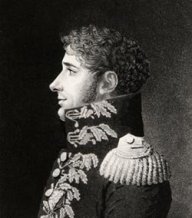 twenty-one, he had command of a battalion. [i]
twenty-one, he had command of a battalion. [i]
It was during this time that he began a vigorous study of military history. John Shy suggests that Jomini was…
“obsessed by visions of military glory, with himself imitating the incredible rise of Bonaparte (below right) who was only ten years his senior, but in a telling phrase Jomini remembers being possessed, even then, by “le sentiment des principes” — the Platonic faith that reality lies beneath the superficial chaos
of the historical moment in enduring and invariable principles, like those of gravitation and probability. To grasp those principle, as well as to satisfy the more primitive emotional needs of ambition and youthful impatience, was what impelled him to the study of war. Voracious reading of military history and theorizing from it would reveal the secret of French victory.” [ii]
The Luneville Treaty of 1801 (see exerpts here) ended the Napoleonic Wars and Jomini returned to Paris where he maintained a devotion to the study and writing of military theory. He had been enthralled by Napoleon’s leadership. It is beyond disptue that the French had achieved a breakthrough in warfare and Jomini was about trying to find out how they had done it.
“Answering this question, persuasively and influentially, would be Jomini’s great achievement. The wars of the French Revolution and Napoleon generated a vast, receptive audience for the
kind of clear, simple, reassuring explanation that he would offer. Drawing overtly on the prestige of ‘science’ and yet almost religious in its insistent evangelical appeal to timeless verities, Jomini’s answer to this troubling question seemed to dispel the confusion and allay much of the fear created by French military victories.” [iii]
By 1804, Jomini had completed his Traité des grandes opérations militaires (Treastise on Great Milita ry Operations). He managed to ingratiate himself to General Michel Ney (right), leader of Bonaparte’s Sixth Corps, who had served for a time as French viceroy in Switzerland. Ney helped him to publish this first book. It would find its way to Napoleon and Jomini’s life would be forever changed. [iv]
ry Operations). He managed to ingratiate himself to General Michel Ney (right), leader of Bonaparte’s Sixth Corps, who had served for a time as French viceroy in Switzerland. Ney helped him to publish this first book. It would find its way to Napoleon and Jomini’s life would be forever changed. [iv]
Jomini’s principles would also find their way to West Point in the years preceeding the American Civil War. In Part III, I’ll discuss what those principles were.
[i] Hugh Chisholm, The Encyclopedia Britannica: A Dictionary of Arts, Sciences, Literature and General Information. 11th Ed, Volume XV. (Cambridge, England: At the University Press, 1911), 495. Accessed online 2/23/2008: here.
[ii, iii, iv] John Shy, “Jomini,” in Makers of Modern Strategy from Machiavelli to the Nuclear Age, ed. Peter Paret (Princeton: Princeton University Press, 1986), 144 – 149.
Photos: Public Domain – Wiki Commons
wig-wags in Greek!
One of the very cool things about blogging is being able to see the sites from which some readers come (referrers as WordPress calls them). Tonight I saw for the first time a referral from a Google’s translation page. I clicked on the page and it appears that I have had a Greek reader checking out the courses page which describes my program! Here’s a screen print. Check it out…wig-wags in Greek! Made my day.

Next Course: “Studies in U.S. Military History”
I just took a break from working on my academic book review due today to register for my next class which starts April 7. “Studies in Military History” is the second in the “core” requirements courses and so deals with more general topics. The first was “Great Military Philosophers.” The course examines the military heritage of the United States from the colonial period to the present. “Through a study of the literature of American military history, this course is a study of the individuals, military policies, postures, organizations, strategies, campaigns, tactics, and battles that have defined the American military experience.”
The reading list looks outstanding. Since I’ve placed my book order, I’ve posted these books on my virtual bookshelves that you can find here. The breadth of conflicts dealt with required that I expand my shelf categories which I’m completely fine with. I’ll post more about each of these as I get into the sememster.
- American Civil War and The Origins of Modern Warfare
- A People’s Army: Massachusetts Soldiers and Sailors in the 7-Year War
- The Army and Vietnam
- Crusade: The Untold Story of the Persian Gulf War
- For the Common Defense: A Military History of the United States of America, Revised and Expanded
- A Revolutionary People at War: The Continental Army and American Character, 1775-1783
- War Without Mercy: Race and Power in the Pacific War
- The Philippine War, 1899-1902
- Doughboys, the Great War, and the Remaking of America
- The GI Offensive in Europe: The Triumph of American Infantry Divisions, 1941-1945
- The Name of War: King Philip’s War and the Origins of American Identity
- Strategies of Containment: A Critical Reappraisal of American National Security Policy During the Cold War
- Cobra II: The Inside Story of the Invasion and Occupation of Iraq
- Their War for Korea: American, Asian, and European Combatants and Civilians, 1945-1953
The instructor, Kelly C. Jordan, also looks excellent (ok they’ve all been excellent).
BA, History, Virginia Military Institute, 1986
PhD, Philosophy, The Ohio State University, 1999
MA, History, The Ohio State University, 1996
From the AMU staff biography site:
Kelly C. Jordan is a Colorado native who received his bachelor’s degree from the Virginia Military Institute but never quite got the hang of the South. Moving to the Midwest, he earned his master’s degree and Ph. D. from The Ohio State University. A retired Army lieutenant colonel, Jordan served for 21 years in the Infantry in mechanized and light units, including service in Operation Desert Shield and Operation Desert Storm. He retired from active duty in August of 2007. He is the author of numerous publications, including works addressing Military History, Military Education, and Strategy. He is currently preparing his Ph.D. dissertation regarding the combat effectiveness of the US Eighth Army in Korea for publication. Dr. Jordan has served on the faculties of the United States Military Academy at West Point, the United States Army Command and General Staff College, the United States Naval War College, and the University of Notre Dame, and he specializes in 20th century post-WWII land warfare, the Korean War, limited war, military leadership, and the development of US Army doctrine. He has won numerous awards for his teaching and writing, he is a huge Notre Dame football fan (even this year!), and he is always looking for ways to incorporate movie clips and other cool things into his classes, discussions, and presentations.
Really looking forward to this class! Now back to my paper!!!
On Historiography and Roman Civil War
 I mentioned in an earlier post that I’m taking a course in Historiography this term. I’m heavily into Ernst Breisach’s Historiography: Ancient, Medieval, and Modern.
I mentioned in an earlier post that I’m taking a course in Historiography this term. I’m heavily into Ernst Breisach’s Historiography: Ancient, Medieval, and Modern. So far, the focus has been on the emergence of Greek and Roman historiography and I have a small essay contrasting the two due this weekend. This is the kind of reading that “wets your whistle” (do people still say that?). We are given a glimpse of the broad picture – a sweeping brush across the centuries before the birth of Christ as men began slowly to understand the value of recorded history and commentary. But we are also introduced to bits of information that are hard to not pursue further. Case in point – a Roman civil war that occurred between 88 and 82 B.C. It was fought between the populares (“favoring people”) under Gaius Marius and the optimates (“the best of men”) under Lucius Cornelius Sulla.i
So far, the focus has been on the emergence of Greek and Roman historiography and I have a small essay contrasting the two due this weekend. This is the kind of reading that “wets your whistle” (do people still say that?). We are given a glimpse of the broad picture – a sweeping brush across the centuries before the birth of Christ as men began slowly to understand the value of recorded history and commentary. But we are also introduced to bits of information that are hard to not pursue further. Case in point – a Roman civil war that occurred between 88 and 82 B.C. It was fought between the populares (“favoring people”) under Gaius Marius and the optimates (“the best of men”) under Lucius Cornelius Sulla.i
Romans killed and exiled Romans on a large scale. The Republic lived on as a mere shell in which the ambitions of men like Sulla, Pompey, and eventually Caesar governed events, often to the detriment of the Republic. For the first time Romans became aware that their life differed greatly from that of their ancestors and that the continuity of Roman tradition had been broken. That experience proved extremely disturbing. How did the past, seen as glorious and ideal, fit with the troubled present? Historical and quasi-historical works were written under the spell of this question.ii
What were the issues over which the bloodbath occurred?
-
Land reform
-
The grasping for political power between factions supporting democratic versus republican ideals, and
-
Class disputes.
Hmmm…. I’ll let you draw your own parallels to our own Civil War.
 Of interest, it was Gaius Marius (left) who reformed the Roman Legion by turning it into a professional army open to men of any class. Volunteers signed up for twenty years and the promise of a pension (land grant) and spoils. Soldiering as a profession was born. The allegiance of the legionnaire shifted from country to commanding general as the awarding of a pension was dependent upon the persuasiveness of the general (not by law).
Of interest, it was Gaius Marius (left) who reformed the Roman Legion by turning it into a professional army open to men of any class. Volunteers signed up for twenty years and the promise of a pension (land grant) and spoils. Soldiering as a profession was born. The allegiance of the legionnaire shifted from country to commanding general as the awarding of a pension was dependent upon the persuasiveness of the general (not by law).
I’ll be adding several links to ancient military history…. including several sections in Bill Thayer’s LacusCurtius (good primary sources like Polybius: The Histories). He has also transcribed to the web The Histories of Appian which chronicle the Appian Civil Wars.
Rene
i, ii Breisach, Ernst. Historiography: Ancient, Medieval, and Modern, 2nd Edition. (Chicago: University of Chicago Press, 1994), 52.
New Class Started Today – Historiography
The next term started today! The class is “Historiography.” I’ve been looking forward to this class in that it steps back an d takes a look at the study of historical thought itself. I also consider it important for the development of solid historical research skills. From the course description, “it concentrates on how history has been interpreted, rather the facts of history themselves. The course contemplates the fundamental questions about the nature of history and investigates the relationships between theory and evidence in historical writing.”
d takes a look at the study of historical thought itself. I also consider it important for the development of solid historical research skills. From the course description, “it concentrates on how history has been interpreted, rather the facts of history themselves. The course contemplates the fundamental questions about the nature of history and investigates the relationships between theory and evidence in historical writing.”
The assignments will actually offer opportunity for some focus on the Civil War but I’m very interested in the more general topic.
I posted the reading list on “the courses” page in case you are interested including the web-based readings. Primary texts include the following:
Bentley, Michael. Modern Historiography: An Introduction. London: Routledge, 1999.
Breisach, Ernst. Historiography: Ancient, Medieval, and Modern, 2nd Edition. Chicago: University of Chicago Pre ss, 1994.
ss, 1994.
Green, Anna, and Kathleen Troup, eds. The Houses of History: A Critical Reader in Twentieth-Century History and Theory. New York: New York University Press, 1999.
Marius, Richard. A Short Guide to Writing about History. NY: Longmans, 1999
Turabian, Kate L. Manual for Writers of Term Papers, 6th Edition. Chicago: University of Chicago Press, 1996.
Currently Reading
Current assigned reading Drawn with the Sword by James McPherson. No doubt more on this later….



